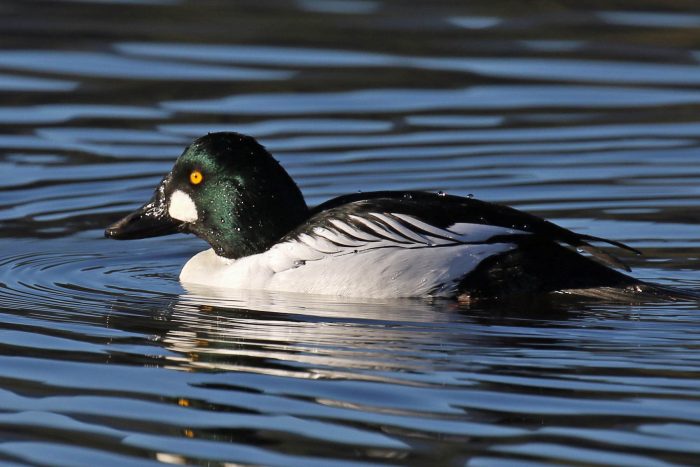Common Goldeneye
Bucephala clangula
The common goldeneye is an active diving duck that can be identified by its golden yellow eyes and white, rounded face patches. It visits the open waters of the Chesapeake Bay and its rivers from late autumn through spring.
This section shows one large critter image at a time. Use the thumbnails that follow to select a specific image to display here.

This gallery contains a grid of small thumbnails. Selecting a thumbnail will change the main image in the preceding section.
Appearance
Male and female goldeneyes have different patterns and coloring. Males have a mostly white body, a black back and a glossy, dark green head. They have a round white patch on the face between their eye and the base of the bill. Females have a chestnut brown head, a gray body and a white “collar” around the neck. The goldeneye's head is large and rounded, with golden yellow eyes and a black bill. This duck grows 15 to 20 inches in length with a wingspan of about 31 inches; males are slightly larger than females.
Feeding
Goldeneyes eat small aquatic animals such as crabs, crayfish, snails, clams and insects. They may also feed on small fish and bits of vegetation. They dive for prey and eat it while underwater.
Predators
Humans hunt goldeneyes. Hawks, owls, eagles and raccoons prey upon females and young on their breeding grounds.
Flight
This duck takes off by running across the water’s surface and flapping its wings. It flies low over the water and high over the land. Its rapid wing beat makes a whistling sound. It can be identified in flight by its white face patches and black-and-white wings.
Voice
The courtship call of male is a high-pitched jeee-ep! Females utter a low quack. The goldeneye is silent during winter, when it is not breeding season.
Reproduction and life cycle
Goldeneyes do not nest and breed in the Bay region; breeding grounds are located throughout Canada and Alaska. They nest in tree cavities formed by woodpeckers. At hatching, goldeneyes’ eyes are grayish-brown. They turn purplish-blue, then blue, then greenish-blue as the bird gets older. By five months old, their eyes become a clear pale greenish-yellow. They eventually turn golden yellow. These ducks can live 11 to 12 years.
Did you know?
- The goldeneye gets its name from its golden yellow eyes. They are also called whistlers because of the whistling sound their wingbeats make.
- During winter, goldeneyes tend to stay as far north as they can while still having ice-free water.
- They can stay underwater for up to 55 seconds.
- Goldeneyes are excellent swimmers that spend most of their time on the water. Like other diving ducks, goldeneyes are clumsy on land because their legs are located far back on their body.
Sources and additional information
- Life in the Chesapeake Bay by Alice Jane Lippson and Robert L. Lippson
- Chesapeake Bay: Nature of the Estuary, A Field Guide by Christopher P. White
- Animal Diversity Web: Bucephala clangula – University of Michigan Museum of Zoology
- Waterfowl ID: Common Goldeneye – Ducks Unlimited
- All About Birds: Common Goldeneye – The Cornell Lab of Ornithology
